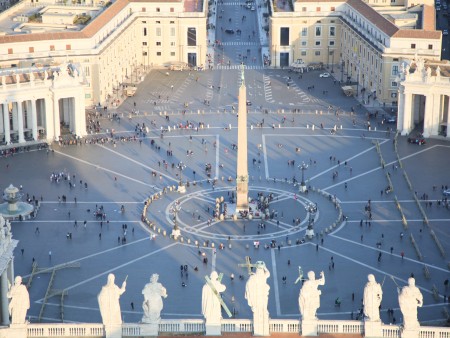Echoes of Tragedy: The Most Famous Ghosts of Rome
The Most Famous Roman Ghost Stories: tragic figures like Beatrice Cenci and the eerie legends of Nero and the mysterious shadows of the Colosseum
02 December 2024
Rome Off the Beaten PathRome, with its grandeur and ancient allure, hides a sinister side beneath its sunlit piazzas and lively streets. The Eternal City is a stage where the restless spirits of the past play out their stories of betrayal, greed, and despair. These ghostly legends, soaked in blood and shrouded in mystery, offer a spine-tingling glimpse into the dark heart of Roman history. Let’s delve into these chilling tales and discover the haunted corners of Rome, where history meets the supernatural. If ghostly tales have sparked your curiosity and you wish to delve deeper into the eerie legends of the Eternal City, discover more on a Rome ghost tour, where you can walk in the footsteps of these tragic spirits and uncover the haunted secrets of Rome’s ancient streets.
1. Beatrice Cenci: The Lady of the Severed Head
Beatrice Cenci’s story is a harrowing tale of revenge, tragedy, and eternal torment. In 1599, she and her family were accused of murdering her tyrannical father, who had abused them for years. After a swift and brutal trial, she was publicly beheaded at Castel Sant’Angelo. But her story didn’t end there. Every September 11, her ghost is said to roam Sant’Angelo Bridge, carrying her own severed head as a symbol of her unjust fate.
Witnesses have reported eerie whispers, the faint clinking of chains, and a chilling drop in temperature as her spectral figure drifts silently across the bridge. Some claim her hollow eyes meet theirs, filled with sorrow and rage. To feel her presence, venture to the bridge after midnight, when the Tiber’s dark waters mirror the haunting glow of the moon, and Beatrice’s anguished spirit may just appear.
2. Donna Olimpia Pamphili (La Pimpaccia): The Fiery Carriage of Ponte Sisto
Donna Olimpia Pamphili, or La Pimpaccia, was a woman of ruthless ambition and greed. Her manipulations earned her immense wealth—and the hatred of the people of Rome. After her death in 1657, stories of her ghost began to surface. She is said to haunt Ponte Sisto, fleeing the Vatican in a ghostly, flaming carriage laden with stolen gold.
Legend says that as her carriage thunders across the bridge, the sound of galloping horses and the creak of wheels shatter the silence of the night. Flames flicker in her wake, and those who dare to approach the bridge have reported a suffocating smell of sulfur and an eerie, mocking laughter echoing through the air. To experience the fearsome legacy of La Pimpaccia, stand at Ponte Sisto during the witching hour and listen for the spectral roar of her fiery escape.
3. Nero’s Restless Spirit at Piazza del Popolo
Emperor Nero’s madness and cruelty left a dark stain on Rome, and his spirit, it seems, refuses to leave. After his death, locals reported hearing screams, wailing, and strange shadows near a walnut tree that grew over his burial site at Piazza del Popolo. In desperation, the Church cut down the tree and built Santa Maria del Popolo, hoping to silence Nero’s tormented soul.
Yet, even today, visitors to the piazza claim to feel his menacing presence. Some report cold drafts and ghostly whispers near the church, while others have seen flickering lights and shadowy figures moving in the corner of their vision. Dare to visit the piazza at dusk, when the fading light casts long, eerie shadows over this haunted square.
4. Vannozza dei Cattanei: The Borgia Matriarch’s Lingering Spirit
Vannozza dei Cattanei, mistress to Pope Alexander VI and mother to the notorious Borgia siblings, was a woman of intrigue and power. After her death, her spirit is said to have remained tied to Campo de’ Fiori, a square known for its dark history of executions and conspiracies.
On quiet nights, locals have reported seeing a ghostly figure dressed in opulent robes, her face pale and her expression stern. Some claim they hear faint whispers of conspiracies and scandals from centuries past. To feel her presence, wander the streets around Campo de’ Fiori under the cover of darkness, where the whispers of her ghost blend with the distant hum of the modern city.
5. Costanza de Curtis: The Mourning Bride of Trastevere
Costanza de Curtis’s tale is one of undying love and eternal sorrow. After her husband was murdered in a violent feud, Costanza wandered the streets of Trastevere in mourning. Her heartbreak was so profound that it left an indelible mark on the neighborhood.
Her ghost, veiled in black, is said to appear near Piazza Santa Maria in Trastevere, weeping silently. Witnesses describe an overwhelming sadness that seems to wash over them when they see her, as if her grief is tangible. To connect with her tragic story, stroll through Trastevere at twilight, when the shadows lengthen, and her spectral figure might just appear.
6. The Screaming Ghost of Palazzo Doria Pamphili
The opulent halls of Palazzo Doria Pamphili hide a grim secret. According to legend, a young woman was murdered here after a forbidden romance was discovered. Her ghost, trapped in eternal anguish, is said to wander the halls, her screams echoing through the corridors.
Visitors have reported hearing sudden, blood-curdling cries that seem to come from nowhere. Some claim to feel a sudden rush of cold air, as if the ghost is passing right by them. Visit the palazzo during the day for its stunning art collection, but as you walk its halls, keep an ear out for the chilling echoes of a love story turned tragedy.
7. The Weeping Nun of Campo de’ Fiori
Campo de’ Fiori, once a site of public executions, carries an aura of sorrow and fear. Among the spirits that haunt the square is that of a nun who fell in love with a man forbidden to her. When their affair was discovered, she was executed, and her spirit has since been seen kneeling near the statue of Giordano Bruno, her face buried in her hands as she weeps.
Some nights, passersby have reported hearing faint sobbing or the sound of soft prayers. A shadowy figure in a nun’s habit has been spotted disappearing into thin air. To feel her sorrowful presence, visit Campo de’ Fiori late at night, when the square’s vibrant energy gives way to an eerie stillness.
8. Giordano Bruno and the Shadows of the Inquisition
In the heart of Campo de’ Fiori stands the imposing statue of Giordano Bruno, a somber reminder of the dark era of the Inquisition. Bruno, a philosopher and free thinker, was condemned as a heretic and burned at the stake in this very square on February 17, 1600. His revolutionary ideas on the cosmos and religion clashed with the rigid doctrines of the Church, sealing his tragic fate.
Even today, the square seems to echo with his defiance and anguish. On quiet nights, locals whisper of a shadowy figure cloaked in a monk’s robe appearing near the statue, his gaze fixed on the ground as if reliving his final moments. Some claim to hear faint murmurs of prayer or impassioned debates carried by the wind, while others report an unsettling chill that seems to envelop the space.
Standing beneath Bruno's statue, you can almost feel the weight of history pressing down, a poignant reminder of the cost of challenging authority. To connect with his story, visit Campo de’ Fiori at twilight, when the bustling market fades into an eerie stillness, and the shadows seem to deepen around the philosopher’s enduring monument.
Our categories:
You may also be interested ...

Vatican Private Tour with Sistine Chapel & St. Peter's Basilica: Renaissance’s Wonders
Private tour
Discover with a skip the line Private Vatican Tour the Sistine Chapel, Vatican Museums and St Peter’s Basilica
starting from: € 275

Colosseum Guided Audio Tour with Roman Forum and Palatine Hill
Private tour
Discover Ancient Rome’s secrets and history with our immersive Colosseum guided audio tour, rich in image and content
starting from: € 51 € 42